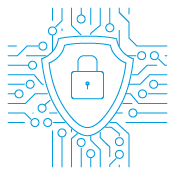eGRC gives organizations a practical, affordable way to manage risk.
Key takeaways


The goal of a data security initiative is to build a framework that’s holistic and resilient.

eGRC-as-a-service delivers a complete set of tools needed to rein in cybersecurity risk.
Risk assessments have emerged as a crucial element in the business and IT landscape. A rapidly changing cybersecurity environment—and constantly shifting vulnerabilities and defense methods—have introduced hazards for organizations of all shapes and sizes.
Assessing and addressing cyber risk factors is no longer optional. The task must be embedded into an organization’s fabric. Yet, protecting a business involves more than surviving attacks, navigating public relations disasters and avoiding regulatory penalties. Assessing and addressing cyber risk factors is no longer optional but must be embedded into an organization's fabric.
Yet, the task isn’t becoming any easier. In the aftermath of the pandemic, an uncertain economy and evolving technology requirements are introducing new and formidable challenges for organizations. Unfortunately, many businesses lack the internal expertise and bandwidth to appropriately evaluate risk and identify a clear strategic path forward.
It’s critical to get a handle on this challenge—and address real-world risks and remedies in a practical and affordable way. One way that organizations are tackling the task is through a managed approach that delivers enterprise governance, risk and compliance (eGRC) as-a-service.
The right controls are critical
A starting point for any discussion about cybersecurity is the recognition that complexity is unavoidable—and taming it requires a clear strategy and the right controls. Acknowledging risk, while crucial, isn’t enough. Frequently, organizations fall short, despite the best of intentions and generous budgets focused on the task.
It’s important to gain broad and deep visibility into the organization. Silos and gaps can transform data security from a challenge into a seemingly impossible morass. Repetitive systems and processes along with the resulting inefficiency can lead to security woes, but also an escalation in costs. In the end, a CISO can lack critical information such as:
- Who and what are creating risk?
- How are groups putting controls around risk?
- How are groups managing and evolving risk management initiatives to fit a changing business, IT and security landscape?
All of this is overlayed by the fact that it has become more difficult to attract and retain an internal CISO and other critical staff in today’s highly competitive labor environment. The typical length of employment for a CISO is about two years, and the chaos, disruption and inconsistency that results from frequent changes often leads to gaps, vulnerabilities and real-world consequences.
Moving to a best practice framework
Data security doesn’t stand still, of course. It requires continuous improvement. Best practices revolve around four key areas:
- Reporting. Ideally, an organization has a single pane of glass for viewing resources and analyzing security protections. With strong reporting functions in place, it’s possible to monitor and detect problems quickly and effectively.
- Workflows. Optimized workflows break down data silos and ensure that business processes are taking place smoothly, without introducing new risks and vulnerabilities.
- Audits. A thorough and ongoing review of people, processes and technologies ensures that potential problems do not fly under the radar. An organization is thereby equipped to make the necessary adjustments along the way.
- Automation. With a single pane of glass and automated controls in place, tasks such as identity access management and DevSecOps are greatly simplified. It’s possible to introduce privileged access, improve testing and monitoring, and tie risk and maturity assessments into technical and regulatory standards and frameworks, such as NIST, eGRC, SOX and HIPAA.
Ultimately, an approach supported by these best practices leads to improved involvement across groups and business units that touch data, digital services, security, tax and audit functions, and other areas. An organization can build a security framework that’s both holistic and designed for resilience over time. In the end, this leads to improved workflow management, reduced overhead and, ideally, the elimination of technical debt.
Why eGRC-as-a-service is a smart choice
While it’s entirely possible for your organization to manage data security services on your own, many organizations are turning to a virtual framework. That’s because eGRC-as-a-service delivers a complete set of tools and resources needed to rein in cybersecurity risk. eGRC-as-a-service tames technical challenges and practical obstacles by putting various tasks and services under a single umbrella.
No less important: eGRC-as-a-service helps manage costs and reduces the need for constant point solution upgrades—as well as rip-and-replace scenarios. The value of this managed framework lies in its ability to provide deep and broad visibility into the status of controls along with the remediation status for these various controls.
The result is improved visibility into gaps and what’s needed to address them. An eGRC-as-a-service provider also should possess a broader view of the overall risk landscape. A trusted provider knows from experience what works and what doesn’t work well in various situations—and across companies and entire industries.
Equally attractive is the fact that an organization gains these capabilities on Day 1. There’s no ramp up time for a CISO and a data security program. The eGRC-as-a-service provider has built-in knowledge and turnkey virtual systems.
Of course, eGRC-as-a-service providers aren’t all equal. Finding the right provider is paramount. This requires a focus on four critical factors:
- Knowledge. It’s important to look for broad experience across industries and technologies. It’s also vital that the managed services provider understands and supports critical security and regulatory standards.
- Metrics. The provider should understand what metrics and KPIs really matter for a specific company—and customize these yardsticks appropriately.
- Experience. A provider should work with other major companies, thus demonstrating a high level of knowledge and performance.
- Flexibility. The company should be agile enough to adapt and adjust to changing conditions fast and responsively. This includes providing highly customized solutions to problems that arise.
To be certain, a risk assessment and a need for more advanced data protection requirements aren’t going away in the months and years ahead. With a single pane of glass and a best-in-class provider for eGRC, it’s possible to elevate risk management and establish a digital data management strategy that’s custom designed for these challenging times.

